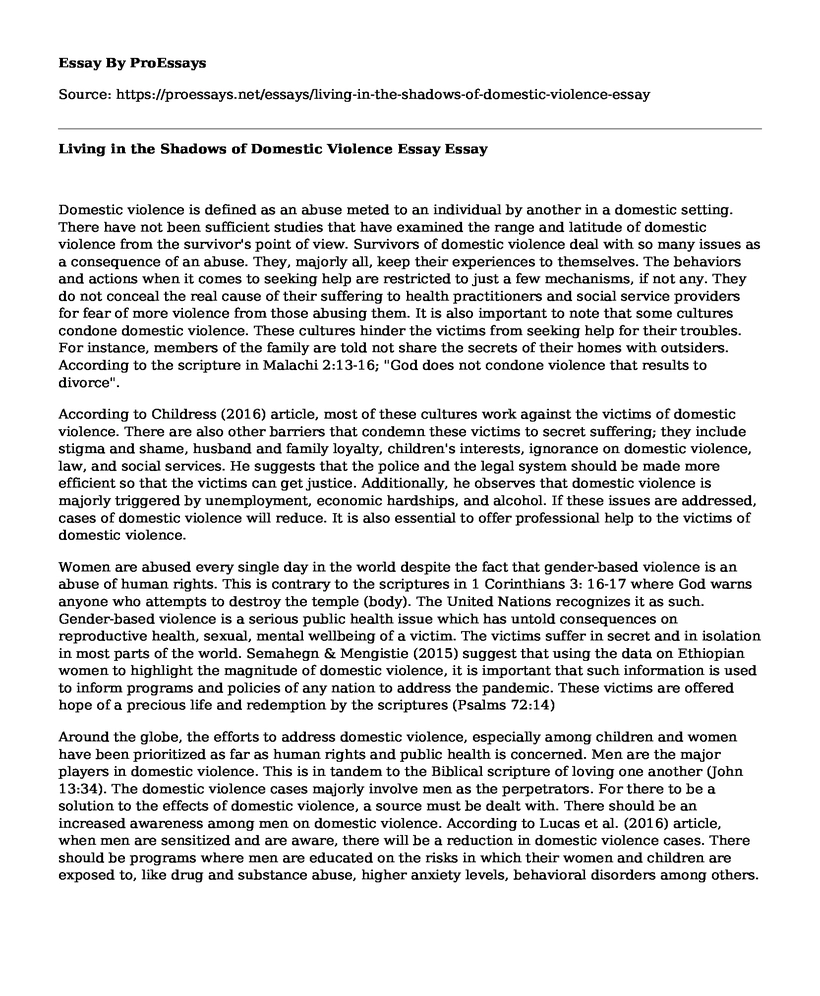Domestic violence is defined as an abuse meted to an individual by another in a domestic setting. There have not been sufficient studies that have examined the range and latitude of domestic violence from the survivor's point of view. Survivors of domestic violence deal with so many issues as a consequence of an abuse. They, majorly all, keep their experiences to themselves. The behaviors and actions when it comes to seeking help are restricted to just a few mechanisms, if not any. They do not conceal the real cause of their suffering to health practitioners and social service providers for fear of more violence from those abusing them. It is also important to note that some cultures condone domestic violence. These cultures hinder the victims from seeking help for their troubles. For instance, members of the family are told not share the secrets of their homes with outsiders. According to the scripture in Malachi 2:13-16; "God does not condone violence that results to divorce".
According to Childress (2016) article, most of these cultures work against the victims of domestic violence. There are also other barriers that condemn these victims to secret suffering; they include stigma and shame, husband and family loyalty, children's interests, ignorance on domestic violence, law, and social services. He suggests that the police and the legal system should be made more efficient so that the victims can get justice. Additionally, he observes that domestic violence is majorly triggered by unemployment, economic hardships, and alcohol. If these issues are addressed, cases of domestic violence will reduce. It is also essential to offer professional help to the victims of domestic violence.
Women are abused every single day in the world despite the fact that gender-based violence is an abuse of human rights. This is contrary to the scriptures in 1 Corinthians 3: 16-17 where God warns anyone who attempts to destroy the temple (body). The United Nations recognizes it as such. Gender-based violence is a serious public health issue which has untold consequences on reproductive health, sexual, mental wellbeing of a victim. The victims suffer in secret and in isolation in most parts of the world. Semahegn & Mengistie (2015) suggest that using the data on Ethiopian women to highlight the magnitude of domestic violence, it is important that such information is used to inform programs and policies of any nation to address the pandemic. These victims are offered hope of a precious life and redemption by the scriptures (Psalms 72:14)
Around the globe, the efforts to address domestic violence, especially among children and women have been prioritized as far as human rights and public health is concerned. Men are the major players in domestic violence. This is in tandem to the Biblical scripture of loving one another (John 13:34). The domestic violence cases majorly involve men as the perpetrators. For there to be a solution to the effects of domestic violence, a source must be dealt with. There should be an increased awareness among men on domestic violence. According to Lucas et al. (2016) article, when men are sensitized and are aware, there will be a reduction in domestic violence cases. There should be programs where men are educated on the risks in which their women and children are exposed to, like drug and substance abuse, higher anxiety levels, behavioral disorders among others.
Conclusion
Media is an integral player in framing issues in society. It frames domestic violence as social problems using various means. According to scriptures in 1 Peter 3:, sympathize with one another, have unity, and help solve problems you have. For example, media can help frame the following concepts; women are as violent as men, social justice for the abused, and empowerment for victims of domestic violence. When media is effectively used, issues of domestic violence will reduce (Berns, 2017). It can be used as an empowerment tool, ridicule tool to the perpetrators, creating awareness on domestic violence and social services and programs available for the victims of domestic violence, like guiding and counseling, legal services, police involvement, among others.
References
Berns, N. S. (2017). Framing the victim: Domestic violence, media, and social problems. Routledge.
Childress, S. (2016). Understanding Lived Experiences, Help-seeking and Coping with Domestic Violence, and Leaving among women in Kyrgyzstan: A Grounded Theory Study (Doctoral dissertation, University of Maryland, Baltimore).
Lucas, P. V., Winter, R. E., Hughes, C. J., & Walsh, K. (2016). Increasing men's awareness of the effects on children exposed to family and domestic violence.
Semahegn, A., & Mengistie, B. (2015). Domestic violence against women and associated factors in Ethiopia; systematic review. Reproductive health, 12(1), 78.
Cite this page
Living in the Shadows of Domestic Violence Essay. (2022, May 17). Retrieved from https://proessays.net/essays/living-in-the-shadows-of-domestic-violence-essay
If you are the original author of this essay and no longer wish to have it published on the ProEssays website, please click below to request its removal:
- Essay Example on Violence in the Media
- Research Paper on Physical Child Abuse
- Essay on Women's Equality: A Critical Conversation on the State of Feminism in the US
- Essay Sample on Women's Suffrage: A Century-Long Battle to Win the Right to Vote
- Essay Sample on Sadiqa Khan's Journey to Understand Race & White Privilege
- Women in WWI: From Home to Warfront - Essay Sample
- Gender and Violence Essay Example







